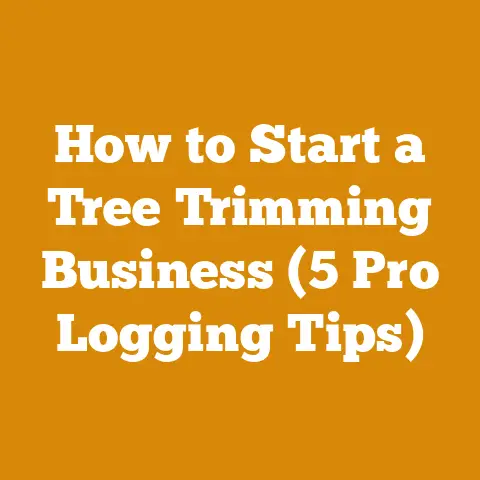Troy Bilt Tomahawk Chipper Shredder (Belt Repair Tips)
Ever bite into an apple and find it unexpectedly soft, a little mushy?
Disappointing, right?
That’s how I feel when my equipment isn’t running at its peak.
And let me tell you, a Troy-Bilt Tomahawk chipper shredder with a slipping or broken belt is a lot like that mushy apple – all potential, but no satisfying crunch.
If you own a Troy-Bilt Tomahawk chipper shredder, you know how invaluable it is for turning yard waste into usable mulch.
But what happens when the belt starts to slip, squeal, or worse, breaks altogether?
Don’t panic!
I’ve been there, wrench in hand, more times than I care to admit.
Understanding the Importance of a Properly Functioning Belt
The belt on your Troy-Bilt Tomahawk is the unsung hero of the machine.
It’s the vital link transferring power from the engine to the chipper and shredder components.
A worn, loose, or broken belt directly impacts performance, efficiency, and even safety.
Without a properly functioning belt, you’ll experience:
- Reduced Chipping and Shredding Power: The machine struggles to process material, leading to clogs and inefficient operation.
- Increased Engine Strain: The engine works harder to compensate for the slipping belt, potentially causing damage and shortening its lifespan.
- Uneven Mulch Production: The chipper and shredder don’t operate at optimal speeds, resulting in inconsistent mulch size.
- Potential Safety Hazards: A severely worn or broken belt can snap unexpectedly, posing a risk of injury.
Replacing the belt is a relatively simple and inexpensive repair that can dramatically improve your Tomahawk’s performance and extend its lifespan.
Identifying Common Belt Problems
Before you start tearing things apart, it’s crucial to diagnose the specific problem.
Here are some common signs of belt trouble:
- Slipping: A noticeable decrease in chipping/shredding power, often accompanied by a squealing or chirping noise.
This usually happens when the belt is worn, stretched, or contaminated with oil or debris. - Squealing: A high-pitched squeal, especially when the machine is under load.
This indicates a loose belt or a belt that’s glazed from slipping. - Cracking: Visible cracks or fraying on the belt’s surface.
This is a sign of age and wear, indicating the belt needs replacement. - Breaking: The belt snaps completely, rendering the chipper shredder unusable.
This is usually caused by excessive wear, improper tension, or foreign objects lodged in the system. - Glazing: The belt surface appears shiny and smooth, indicating it has been slipping and overheating.
My Experience: I once spent an entire afternoon battling a Tomahawk that kept clogging.
I cleaned the hopper, sharpened the blades, and even adjusted the discharge chute.
Finally, I checked the belt and discovered it was glazed and stretched.
A new belt solved the problem instantly!
Lesson learned: always check the belt first.
Tools and Materials You’ll Need
Before diving into the repair, gather the necessary tools and materials.
Having everything on hand will make the process smoother and more efficient.
- New Replacement Belt: Use the correct belt size and type specified in your Tomahawk’s owner’s manual.
This is crucial for proper operation and longevity. - Wrench Set: A set of standard wrenches is essential for loosening and tightening bolts.
Metric sizes may also be needed depending on your model. - Socket Set: A socket set provides more leverage and versatility than wrenches, especially for stubborn bolts.
- Screwdrivers: Both flathead and Phillips head screwdrivers will come in handy for removing covers and accessing the belt.
- Pliers: Pliers are useful for gripping and manipulating small parts.
- Belt Tension Gauge (Optional): A belt tension gauge allows you to accurately measure belt tension for optimal performance.
- Work Gloves: Protect your hands from dirt, grease, and sharp edges.
- Safety Glasses: Protect your eyes from debris.
- Pen and Paper: To note the order of disassembly, which is especially helpful if you are new to this.
- Owner’s Manual: Your owner’s manual contains valuable information, including belt specifications, diagrams, and safety instructions.
Don’t skip this!
Pro Tip: Keep a dedicated toolbox specifically for your outdoor power equipment.
This will save you time and frustration when you need to make repairs.
Step-by-Step Guide to Replacing the Belt
Now for the main event: replacing the belt.
This process may vary slightly depending on your specific Tomahawk model, so always refer to your owner’s manual for detailed instructions.
However, the general steps are as follows:
Step 1: Safety First!
- Disconnect the Spark Plug: This is the most important safety precaution.
Disconnecting the spark plug wire prevents the engine from accidentally starting during the repair.
Locate the spark plug on the engine and pull the wire off. - Allow the Machine to Cool Down: If the engine has been running, allow it to cool completely before starting the repair.
Step 2: Accessing the Belt
- Remove the Belt Guard: Most Tomahawk models have a belt guard that protects the belt and pulleys.
This guard is usually held in place by screws or bolts.
Use the appropriate screwdriver or wrench to remove the fasteners and carefully remove the guard. - Consult your manual: Your owner’s manual will be key in showing you exactly where the belt guard is and how to remove it.
Step 3: Removing the Old Belt
- Loosen the Tension Pulley: The belt tension pulley maintains proper tension on the belt.
Loosen the tension pulley by loosening the adjustment bolt or lever.
This will allow you to remove the old belt. - Remove the Old Belt: Carefully slide the old belt off the engine pulley and the chipper/shredder pulley.
Inspect the pulleys for any damage or debris. - Inspect the Pulleys: Before installing the new belt, inspect the pulleys for wear, damage, or debris.
Clean them with a wire brush if necessary.
My Experience: One time, I found a small twig wedged between the belt and the pulley.
This caused the belt to slip and eventually break.
Always make sure the pulleys are clean and free of obstructions.
Step 4: Installing the New Belt
- Install the New Belt: Place the new belt around the engine pulley and the chipper/shredder pulley.
Make sure the belt is properly seated in the grooves of both pulleys. - Tension the Belt: Adjust the tension pulley to achieve the correct belt tension.
Refer to your owner’s manual for the recommended tension specifications.
If you have a belt tension gauge, use it to ensure accurate tension.
If you don’t have a gauge, a good rule of thumb is that the belt should deflect about 1/2 inch when pressed firmly in the middle of its longest span. - Make sure the belt is properly seated: Double-check that the belt is correctly positioned on both pulleys.
Step 5: Reassembly
- Reinstall the Belt Guard: Reattach the belt guard using the screws or bolts you removed earlier.
Make sure the guard is securely in place. - Reconnect the Spark Plug Wire: Reconnect the spark plug wire to the spark plug.
Step 6: Testing and Adjustments
- Start the Engine: Start the engine and let it run for a few minutes.
Observe the belt for any signs of slipping, squealing, or vibration. - Adjust Tension as Needed: If the belt is slipping or squealing, adjust the tension pulley until the problem is resolved.
- Test with Material: Run some material through the chipper/shredder to ensure it’s operating correctly.
Important Note: After the first few hours of operation, recheck the belt tension.
New belts can stretch slightly, requiring a minor adjustment.
Understanding Belt Tension
Proper belt tension is crucial for optimal performance and belt longevity.
Too little tension will cause the belt to slip, while too much tension can damage the belt and the pulleys.
Methods for Checking Belt Tension:
- Belt Tension Gauge: A belt tension gauge provides the most accurate measurement of belt tension.
Follow the manufacturer’s instructions for proper use. - Deflection Method: This method involves measuring the amount the belt deflects when pressed firmly in the middle of its longest span.
As mentioned earlier, a deflection of about 1/2 inch is generally recommended. - The “Feel” Method: With experience, you can develop a feel for proper belt tension.
The belt should be firm but not overly tight.
This method is less precise but can be useful for making minor adjustments.
Tips for Adjusting Belt Tension:
- Refer to Your Owner’s Manual: Your owner’s manual contains the recommended belt tension specifications for your specific model.
- Adjust Gradually: Make small adjustments to the tension pulley and recheck the tension after each adjustment.
- Avoid Over-Tightening: Over-tightening the belt can damage the belt and the pulleys.
- Check After Initial Use: As mentioned earlier, recheck the belt tension after the first few hours of operation.
Choosing the Right Replacement Belt
Selecting the correct replacement belt is essential for ensuring proper operation and longevity.
Here are some factors to consider:
- Belt Type: There are different types of belts, including V-belts, cogged belts, and banded belts.
Use the type specified in your owner’s manual. - Belt Size: The belt size is determined by its length and width.
Use the exact size specified in your owner’s manual. - Material: Belts are typically made of rubber or synthetic materials.
Choose a high-quality belt that is designed for outdoor use. - Brand: Stick with reputable brands known for producing durable and reliable belts.
Troy-Bilt often recommends specific belt brands for their equipment.
My Recommendation: I always recommend using a belt that meets or exceeds the original equipment manufacturer (OEM) specifications.
While aftermarket belts may be cheaper, they may not provide the same level of performance or durability.
Maintaining Your Tomahawk’s Belt System
Regular maintenance is essential for extending the life of your Tomahawk’s belt system.
Here are some tips:
- Inspect the Belt Regularly: Inspect the belt for wear, cracks, and damage.
Replace the belt if you notice any signs of deterioration. - Keep the Pulleys Clean: Keep the pulleys clean and free of debris.
Use a wire brush to remove any buildup. - Maintain Proper Belt Tension: Check and adjust the belt tension regularly.
- Store the Machine Properly: When storing the machine for extended periods, loosen the belt tension to prevent stretching.
- Avoid Overloading the Machine: Overloading the machine can put excessive strain on the belt, leading to premature wear.
- Use the Correct Material: Only use the materials that the manufacturer has stated are safe to use in the Tomahawk.
Troubleshooting Common Belt Problems
Even with proper maintenance, you may encounter belt problems from time to time.
Here are some common issues and how to troubleshoot them:
- Belt Slipping:
- Cause: Worn belt, loose tension, contaminated belt.
- Solution: Replace the belt, adjust the tension, clean the belt and pulleys.
- Belt Squealing:
- Cause: Loose tension, glazed belt.
- Solution: Adjust the tension, replace the belt.
- Belt Breaking:
- Cause: Excessive wear, improper tension, foreign objects.
- Solution: Replace the belt, adjust the tension, remove any foreign objects.
- Belt Coming Off:
- Cause: Misalignment of pulleys, worn pulleys, incorrect belt size.
- Solution: Align the pulleys, replace the pulleys, use the correct belt size.
My Troubleshooting Tip: If you’re experiencing persistent belt problems, take a close look at the pulleys.
Worn or damaged pulleys can cause the belt to slip, squeal, or break prematurely.
Safety Precautions
Working with power equipment can be dangerous. Always follow these safety precautions:
- Disconnect the Spark Plug: Always disconnect the spark plug wire before performing any maintenance or repairs.
- Wear Safety Glasses: Protect your eyes from debris.
- Wear Work Gloves: Protect your hands from dirt, grease, and sharp edges.
- Read the Owner’s Manual: Familiarize yourself with the safety instructions and operating procedures in your owner’s manual.
- Work in a Well-Ventilated Area: If you’re working with gasoline or other flammable liquids, work in a well-ventilated area.
- Keep Children and Pets Away: Keep children and pets away from the work area.
- Use Common Sense: Always use common sense and exercise caution when working with power equipment.
Advanced Tips and Tricks
Here are some advanced tips and tricks I’ve learned over the years:
- Use Belt Dressing: Belt dressing can help to improve belt grip and reduce slipping.
However, use it sparingly, as excessive use can attract dirt and debris. - Consider a Cogged Belt: Cogged belts (also known as notched belts) provide better grip and flexibility than standard V-belts.
They can be a good option for demanding applications. - Keep a Spare Belt on Hand: It’s always a good idea to keep a spare belt on hand so you can quickly replace a broken belt and get back to work.
- Lubricate the Tension Pulley: Lubricate the tension pulley regularly to ensure smooth operation.
- Clean the Engine Pulley: Use a wire brush to clean the engine pulley on a regular basis.
My Favorite Trick: I like to use a small amount of silicone spray on the belt after cleaning it.
This helps to keep it pliable and prevents it from drying out and cracking.
Case Studies: Real-World Belt Repair Scenarios
Let’s look at a few real-world scenarios where belt repair was necessary:
Case Study 1: The Squealing Tomahawk
- Problem: A homeowner’s Tomahawk started squealing loudly whenever it was used.
- Diagnosis: The belt was glazed and stretched, indicating it had been slipping.
- Solution: The belt was replaced with a new OEM belt, and the tension was properly adjusted.
The squealing stopped, and the machine operated smoothly.
Case Study 2: The Broken Belt on a Logging Site
- Problem: A logger’s Tomahawk’s belt snapped in the middle of a project.
- Diagnosis: The belt had been overloaded with large branches, causing it to break.
- Solution: The logger replaced the belt with a heavy-duty cogged belt and adjusted the tension.
He also made sure to feed the machine smaller branches to avoid overloading it.
Case Study 3: The Clogging Chipper Shredder
- Problem: A landscaper’s Tomahawk kept clogging, even with sharp blades.
- Diagnosis: The belt was slipping due to a loose tension pulley.
- Solution: The landscaper tightened the tension pulley and cleaned the belt and pulleys.
The clogging issue was resolved.
Global Perspectives on Wood Processing and Tool Maintenance
While I’ve focused on the Troy-Bilt Tomahawk, the principles of belt maintenance apply to chipper shredders and other wood processing equipment worldwide.
I’ve seen similar issues and solutions in various contexts:
- Small-Scale Logging in Developing Countries: In many developing countries, small-scale loggers rely on basic equipment and often face challenges in obtaining replacement parts.
Proper maintenance, including regular belt inspections and tension adjustments, is crucial for maximizing the lifespan of their equipment. - Firewood Production in Cold Climates: In regions with long, cold winters, firewood is a vital source of heat.
Efficient wood processing is essential, and a properly functioning chipper shredder can significantly speed up the process.
Regular belt maintenance ensures that the machine operates at its peak performance. - Urban Gardening and Composting: In urban areas, chipper shredders are used to process yard waste for composting and mulching.
Maintaining the belt system is important for reducing noise and emissions, which can be a concern in densely populated areas.
Metrics for Success: Measuring Your Belt Maintenance Efforts
How do you know if you’re doing a good job maintaining your Tomahawk’s belt system?
Here are some metrics to track:
- Belt Lifespan: Track how long your belts last.
A well-maintained belt should last for several years. - Downtime: Monitor the amount of time your machine is out of service due to belt problems.
Aim to minimize downtime through regular maintenance. - Material Processing Rate: Measure how much material you can process per hour.
A properly functioning belt system will allow you to process more material efficiently. - Fuel Consumption: Track your fuel consumption.
A slipping belt can cause the engine to work harder, increasing fuel consumption. - Noise Level: Monitor the noise level of your machine.
A squealing belt can be a sign of a problem.
By tracking these metrics, you can identify potential problems early and take corrective action to keep your Tomahawk running smoothly.
Conclusion: Keeping Your Tomahawk Humming
Replacing and maintaining the belt on your Troy-Bilt Tomahawk chipper shredder might seem like a minor task, but it has a significant impact on the machine’s performance, efficiency, and longevity.
By following the steps outlined in this guide, you can keep your Tomahawk humming for years to come.
Remember, safety is always the top priority.
Disconnect the spark plug, wear safety glasses and work gloves, and read your owner’s manual before starting any repair.
With a little knowledge and effort, you can keep your Tomahawk in top condition and enjoy the benefits of efficient wood processing for years to come.
Now get out there and make some mulch!






